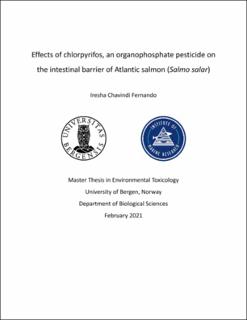| dc.contributor.author | Fernando, Iresha Chavindi | |
| dc.date.accessioned | 2021-03-20T00:50:07Z | |
| dc.date.available | 2021-03-20T00:50:07Z | |
| dc.date.issued | 2021-03-20 | |
| dc.date.submitted | 2021-03-19T23:00:26Z | |
| dc.identifier.uri | https://hdl.handle.net/11250/2734579 | |
| dc.description.abstract | Aquaculture is the fastest growing food producing sector worldwide. The decline in capture fisheries has led to a decrease in fish oil and fish meal production. Due to this decline, there is a need for alternative lipid and protein sources in fish feed. Lipid and protein sources of plant origin has been increasingly replacing fish ingredients. Today fish feed typically contains about 70 % plant ingredients. Replacement of plant ingredients has reduced hazardous environmental contaminants such as dioxins and polychlorinated biphenyls (PCBs) in fish feed. However, is has also been introduced new undesirable substances, such as chlorpyrifos (CPF) which is an organophosphate pesticide. In this study the effects of CPF were investigated on intestinal permeability of Atlantic salmon. Apparent permeability was measured on the mid intestinal section of fish injected with 500 µM CPF for 3 hours, using the gut sac model. Furthermore, an intestinal cell line (RTgutGC) derived from rainbow trout was also used as an in vitro model for Atlantic salmon. The transepithelial electrical resistance (TEER) was measured in cells exposed to 0.5 – 500 µM CPF for 24 hours. The transcriptional levels of several genes involved in detoxification and lipid metabolism was also quantified with the same dose range of CPF exposed to 24 hours, with real-time PCR. Cytotoxicity was determined by the xCELLigence system in cells exposed to 0.05 – 500 µM CPF for 24 hours. Results from the gut sac model showed that CPF had no effect on the intestinal permeability and histological evaluation showed no inflammation in the epithelium. High TEER values indicated increased permeability of cells exposed to high concentrations of CPF. Most of the studied genes did not respond to CPF, but a downregulation of genes was seen when cells were exposed to high concentrations of CPF. xCELLigence system showed that cells exposed to CPF concentrations of 50 µM and upwards induce cytotoxicity. In conclusion the gut sac model showed no effects of CPF at 500 µM on the intestinal sac of fish while the RTgutGC cell line model showed the CPF at 500 µM was highly toxic to CPF inducing 100 % cell death. The difference in the CPF toxicity at 500 µM may be explained by duration of the exposure period, differences between the model systems and species differentiation. Further research is required to investigate whether the RTgutGC cell model is good in vitro model for salmon when studying the effects of CPF. | |
| dc.language.iso | eng | |
| dc.publisher | The University of Bergen | |
| dc.rights | Copyright the Author. All rights reserved | |
| dc.title | Effects of chlorpyrifos, an organophosphate pesticide on the intestinal barrier of Atlantic salmon (Salmo salar) | |
| dc.type | Master thesis | |
| dc.date.updated | 2021-03-19T23:00:26Z | |
| dc.rights.holder | Copyright the Author. All rights reserved | |
| dc.description.degree | Master's Thesis in Biology | |
| dc.description.localcode | BIO399 | |
| dc.description.localcode | MAMN-HAVSJ | |
| dc.description.localcode | MAMN-BIO | |
| dc.subject.nus | 751999 | |
| fs.subjectcode | BIO399 | |
| fs.unitcode | 12-60-0 | |
